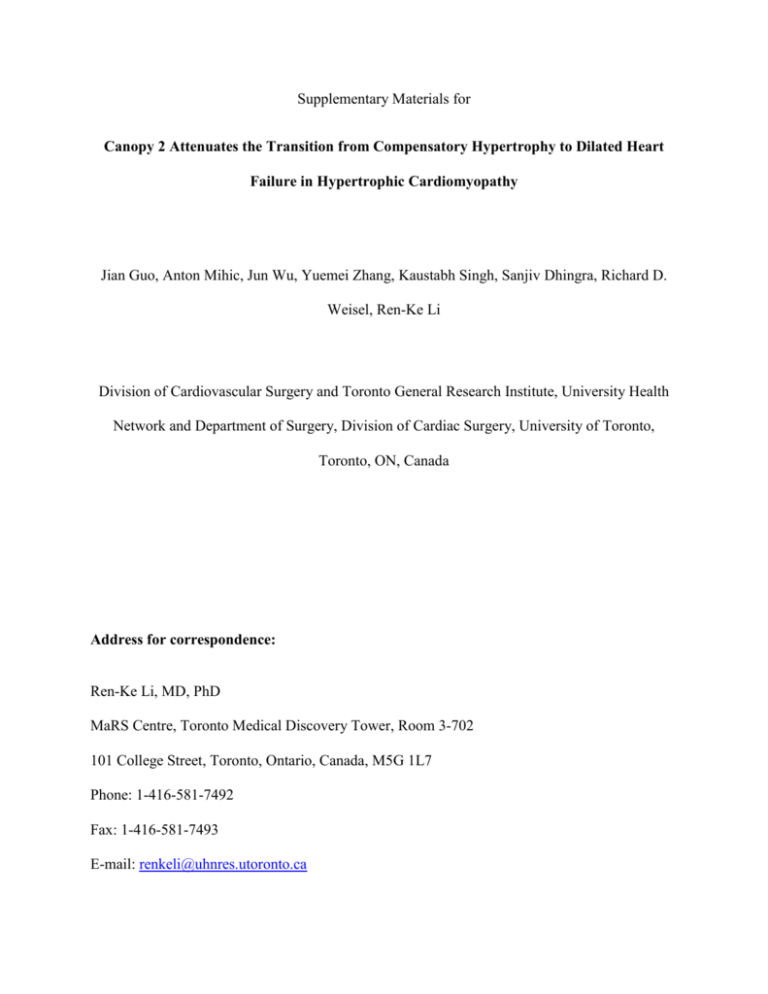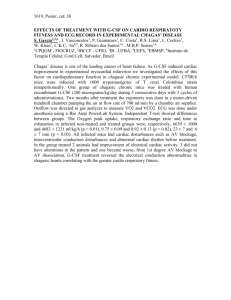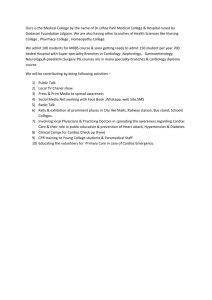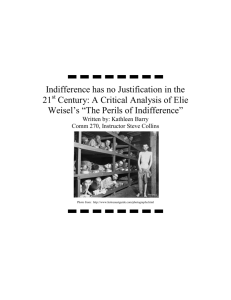Supplementary Data - European Heart Journal
advertisement

Supplementary Materials for Canopy 2 Attenuates the Transition from Compensatory Hypertrophy to Dilated Heart Failure in Hypertrophic Cardiomyopathy Jian Guo, Anton Mihic, Jun Wu, Yuemei Zhang, Kaustabh Singh, Sanjiv Dhingra, Richard D. Weisel, Ren-Ke Li Division of Cardiovascular Surgery and Toronto General Research Institute, University Health Network and Department of Surgery, Division of Cardiac Surgery, University of Toronto, Toronto, ON, Canada Address for correspondence: Ren-Ke Li, MD, PhD MaRS Centre, Toronto Medical Discovery Tower, Room 3-702 101 College Street, Toronto, Ontario, Canada, M5G 1L7 Phone: 1-416-581-7492 Fax: 1-416-581-7493 E-mail: renkeli@uhnres.utoronto.ca Supplementary Methods Transgenic Mice All animal studies were approved by the Animal Care Committee of the University Health Network and were performed in accordance with the “Guide for the Care and Use of Laboratory Animals, 8th edition” (NIH, revised 2011). We generated cardiac-specific transgenic (TG) mice that carry human CNPY2 driven by the α-myosin heavy chain (α-MHC) promoter (Supplementary Figure 1 and Supplementary Tables 1–3). The transgenic construct also expressed EGFP, and human CNPY2 and endogenous mouse Cnpy2 could be differentiated by species-specific PCR primers. The final construct was linearized and microinjected into one-cell C57BL6 embryos that were transferred into the oviduct of pseudopregnant CD1 mice. In total, six founders were obtained and bred with wild-type C57BL6 mice, and four independent transgenic lines were used for experiments. Transverse Aortic Constriction (TAC) model Pressure overload of the left ventricle (LV) was induced by TAC in wild-type (WT) and TG mice as previously described with minor modifications (1). Briefly, under general anaesthesia, the aorta was exposed and ligated between the innominate and left common carotid arteries by tying a 7-0 silk suture around a 27-gauge needle placed parallel to the aorta. The needle was then removed, leaving the ligature in place, causing constant and permanent aortic constriction. The incision was closed and buprenorphine (0.05mg/kg) was administered for analgesia. Echocardiography and Cardiac Function Cardiac systolic function was evaluated by echocardiography prior to (0) and 1, 2, 4, 8 and 12 weeks after TAC. Mice were sedated with a 2% isoflurane (Pharmaceutical Partners of Canada) nosecone. Echocardiographic examinations were performed using a GE Vivid 7 ultrasound system (GE Healthcare Canada) with an i13L transducer. Depth and frequency were set at 1cm and 14MHz, respectively. Short-axis views were obtained from the parasternal approach. LV dimensions [left ventricular end-diastolic internal diameter (LVIDd) and endsystolic internal diameter (LVIDs)] and posterior wall thickness (PWT) were measured in Mmode at short-axis views of the LV at mid-level. Fractional shortening was calculated as follows: [(LVIDd−LVIDs)/LVIDd]×100. Cardiac diastolic function was also evaluated using a pressure–volume (P–V) catheter at 1, 4 and 12 weeks after TAC. Briefly, under general anesthesia with 2% isoflurane and positive pressure ventilation, a calibrated Millar and conductance P–V catheter (Millar Instruments) was inserted into the LV cavity through the right carotid artery. Real-time P–V loops were constructed and adjusted for parallel conductance. The diastolic functional parameters dp/dtmin (maximal rate of LV pressure decrease) and Tau (time constant of LV pressure decay) were calculated using PVAN 3.3 software (Millar Instruments) as previously described (2). Histology and immunohistochemistry The heart morphology of WT and TG mice was evaluated histologically at 4 and 12 weeks after initial surgery. Briefly, hearts were excised and arrested in diastole with 1M KCl buffer, followed by washing and perfusion fixation with 10% neutral buffered formalin (Sigma). After 72h, hearts were sectioned into 1mm thick rings and photographed. Myocardial crosssections were embedded in paraffin and 5μm serial sections were cut. To confirm the expression of CNPY2 and EGFP protein in TG mice, sections were deparaffinized and rehydrated, and underwent antigen retrieval in 10mM sodium citrate (pH 6.0), 0.05% Tween 20. Samples were boiled in a microwave pressure cooker for 20min, followed by permeabilization with 0.25% Triton X-100 at room temperature for 5min. Cross-sections were blocked with 10% normal donkey serum for 20min, and then probed with anti-rabbit CNPY2 (1:100, custom-made polyclonal antibody) and anti-goat GFP (1:100, Santa Cruz Biotechnology sc-5385) primary antibodies for 2h at room temperature. Secondary antibodies were donkey antirabbit Alexa Fluor 568 (1:400, Life Technologies) and donkey anti-goat Alexa Fluor 647 (1:400, Life Technologies) for 1h at room temperature. Tissues were also stained with 4',6-diamidino-2phenylindole (DAPI) to identify cell nuclei (1:4000, 5min, Sigma). Whole slide scans were performed at 20× using a fluorescence slide scanner. GFP signal was obtained in the CY5 far-red channel as there was noticeable autofluorescence caused by fixation in formalin, but the final image was pseudo-coloured green. Imaging parameters were the same for all samples including exposure, gain, threshold and contrast. Hematoxylin and eosin staining was carried out as previously described (2). Stained sections were scanned with a whole-slide scanner (Olympus VS-120, Olympus). Comparison of cross sections was made possible by landmarking with the papillary muscles so that the same longitudinal plane could be measured. To quantify cardiac morphology, Cellsens software (Olympus) was used to accurately quantify whole-heart cross-sectional area and circumference. To assess LV parameters, LV free wall was defined as a 180° portion of the cross section containing the papillary muscle structures, but not including the wedge-shaped thickening and bifurcating portion of the myocardium bordering the ventricular septum. This measurement facilitated the quantification of LV circumference and LV free wall area. To measure LV free wall thickness, an average of five evenly spaced measurements was taken at 90° to the endocardial wall, and not through the papillary muscles. As these measurements were simple representations of cardiac morphology for one anatomical location in fixed hearts, further measurements were obtained from the working heart through echocardiography at various time points throughout the study. Assessment of cardiac vasculature Capillary and arteriolar structure density was assessed at 4- and 12-weeks post-TAC using GS-Isolectin-B4 (isolectin) and α-smooth muscle actin (α-SMA) staining, respectively. Cardiac sections were deparaffinized and rehydrated, followed by permeabilization with 0.25% Triton X-100 for 5min at room temperature. Tissues were blocked with 10% normal donkey serum for 20min, and subsequently incubated with 30μg/ml GS-Isolectin-B4-conjugated Alexa Fluor-568 (Life Technologies) and 1:400 anti-α-SMA (Sigma A2547) for 2h at room temperature. Slides were then washed and incubated with donkey anti-mouse Alexa Fluor-647 secondary antibody (1:400, 1h, Life Technologies). Nuclei were stained with DAPI (1:4000, 5min). To ensure that samples could be directly compared for quantification, all staining was carried out simultaneously under identical conditions. Additionally, all microscopy was performed using the same excitation, exposure, gain and contrast settings. Imaging was performed using a whole-slide fluorescence scanner (Olympus VS-120) and images were obtained at 20× in four channels corresponding to DAPI (blue), autofluorescence (green), isolectin (red) and α-SMA (far-red). For capillary density, isolectin-positive representative images were obtained for capillaries in the transverse (cross-sectional) and longitudinal axes. Quantification was carried out using Cellsens software by thresholding the red channel for signal detected within the LV free wall and expressed as percentage area. The total number of distinct capillary structures was also quantified and normalized/mm2. Similarly, arteriolar structures (pseudo-coloured red) were also quantified as a percentage of total LV free wall area. We manually counted the total number of distinct α-SMA-positive structures possessing a clearly defined lumen/mm2 of LV free wall. This parameter allowed for the differentiation of thickening or enlargement of arteriolar structures versus a change in the overall density in the vasculature. Cardiac apoptosis Programmed cell death was assessed using TUNEL, which labels DNA stand breaks, following the manufacturer’s instructions (Roche). Positive and negative control slides were used to confirm the sensitivity of the assay and preclude the possibility of false negative signals. Cardiac sections were deparaffinized and rehydrated as above, but did not undergo antigen retrieval. Slides were incubated in 5μg/ml Proteinase K working solution at 37°C for 10min, followed by permeabilization in 0.1% sodium citrate, 0.1% Triton X-100 for 10min at room temperature. Tissues were labeled with enzyme solution and fluorescein following the manufacturer’s guidelines for 1h at 37°C in the dark. Nuclei were stained with DAPI so TUNEL co-localization could be confirmed (1:4000, 5min). The total number of nuclei in the LV free wall, as well as the total number of co-localized TUNEL-positive nuclei were counted using Cellsens software (Olympus), and expressed as a percentage at 4 and 12 weeks following TAC. For caspase-9 and -3 colourimetric assays, 100µg of myocardial tissue lysate was used and absorbance was measured at OD405nm according to the manufacturer’s instructions (BioVision). Cardiac fibrosis Assessment of cardiac fibrosis was performed by staining cardiac cross sections with picrosirius red (PSR) as reported previously (3). Whole-slide bright field images were assessed using Cellsens software (Olympus) and RGB thresholding allowed for the specific quantification of PSR-positive staining. This quantification was only performed for the LV free wall as defined above. Total PSR-positive area was normalized to the total area of the LV free wall and expressed as a percentage. We also used circularly polarized light microscopy of the same slides to visualize the relative abundance of thin (green) and thick (bright yellow/orange) collagen fibers, a well-characterized birefringence property of collagen. Total collagen (thin + thick) composition was measured and normalized to total LV free wall area. The ratio of thick/thin collagen fibers was obtained by thresholding specifically against the red light component of the polarized images and normalizing it to the green light component. At day 0–21 following TAC, the activity of myocardial Mmp9 was quantified using gelatin zymography as described previously (4). Briefly, LV tissues were homogenized in MMP extraction buffer [1% SDS, 50mM Tris-HCl (pH 7.6), 150mM NaCl, 20mM ZnCl2, 1.5mM NaN3, and 10mM cacodylic acid]. After centrifugation, 20μg of total protein was added to 5× sample buffer [10% glycerol, 2% SDS, 0.5% bromophenol blue, 0.5M Tris-HCl (pH 6.8)] and resolved by 10% SDS-PAGE) containing 0.1% gelatin (Invitrogen). After electrophoresis, the gels were rinsed twice in 2.5% Triton X-100 renaturing buffer for 30 min, followed by incubation in developing buffer [50mM Tris (pH 8.8), 5mM CaCl2, 0.02% NaN3] at 37°C for 24h. Gels were stained in Coomassie Brilliant Blue followed by destaining, and gelatinase activity was identified as clear bands on a blue background. Densitometry of the target bands was quantified using AlphaImager 2200 software and was expressed as the relative fold change compared to the WT sham control group. Western blot and ELISA Total protein was extracted from mouse hearts or other tissues in lysis buffer [20mM Tris (pH 7.4), 150mM NaCl, 1mM EDTA, 1mM EGTA, 1% Triton, 2.5mM sodium pyrophosphate, 1mM -glycerolphosphate, 1mM Na3VO4, 1µg/mL leupeptin, 1µg/mL pepstatin, 1mM phenylmethylsulfonyl fluoride]. The rabbit-anti-CNPY2 polyclonal antibody was raised and purified as previously described (5). Antibody for CNPY2, p53 or Hif-1α (Abcam) was incubated with the blots overnight at 4°C. After washing three times for 5min in Tris-buffered saline, 0.1% Tween-20, the blots were incubated with horseradish peroxidase-conjugated secondary antibody (1:5000) for 1h at room temperature. Visualization was performed with enhanced chemiluminescence. For quantification, densitometry of the target bands was divided by the corresponding densitometry of the Gapdh band using AlphaImager 2200 software. The values were expressed as the relative fold change of densitometry of gene/Gapdh compared to the sham control group. The CNPY2 ELISA kit was purchased from MybioSource. For measurement of secreted CNPY2 in WT or TG mouse blood, serum was obtained after 2h of clotting and centrifuged at 2000×g for 20min at room temperature. 100µl of serum was used. The absolute amount of CNPY2 was expressed as pg/mL, according to the manufacturer’s instructions. RNA extraction, RT-PCR, and real-time PCR Total RNA was isolated from whole heart tissues from WT or TG mice using Trizol reagent (Sigma) according to the manufacturer’s instructions. Reverse transcription was performed using SuperScript III (Invitrogen) at 50°C for 60 min. For PCR amplification, samples were heated at 95°C for 5min, followed by 30 cycles of 95°C for 30s, 55°C for 30s, 72°C for 1min, and 72°C for an extra 10min at the end of amplification. The RT-PCR products were separated on a 1.5% agarose gel containing ethidium bromide. Mouse Gapdh served as a loading control. The sequences of the primers used in RT-PCR are provided in Supplemental Table 5. Taqman probe-based real-time PCR was performed using a GeneAmp PCR 9600 Thermocycler (Life Technologies) for 40 cycles at 95°C for 15s, 60°C for 1min. Mouse β-actin was used as the internal loading control. The sequences of the primers and probes used in realtime PCR are provided in Supplemental Table 6. Relative expression was calculated by the comparative threshold cycle method, and the relative fold change in the experimental group compared to sham controls was expressed as 2-[ (CT of Gene of Interest-CT of control) in experiment-(CT of Gene of Interest-CT of control) in sham . Statistics Data are presented as mean±standard deviation (SD). The sample size of 5 mice/experimental group was statistically determined, using an α probability of 0.05, a β of 0.8 and an expected SD of 1.5 (based on previous studies from our group and others, 6–9). The echocardiographic measures, which evaluated the same animals at different timepoints, were analyzed by linear regression models adjusted for repeated measures using SAS v9.3 (SAS Institute). For each outcome, a compound symmetry covariance structure was used to generate general estimating equations with the maximum likelihood estimate method for parameter estimation. Two sets of regression models were created, one directly comparing average values between the 2 groups and one comparing the slope of change over time. All other statistical analyses were performed using GraphPad Prism 5 (GraphPad). A two-tailed Student’s t-test was used to compare CNPY2 levels in blood serum in WT and TG mice. One-way ANOVAs followed by Tukey post-hoc tests were used to evaluate differences in gene expression over time in WT mice. All other comparisons were analyzed by two-tailed ANOVAs followed by Bonferroni post-hoc tests. Differences were considered statistically significant at P<0.05. References 1. Hu P, Zhang D, Swenson L, Chakrabarti G, Abel ED, Litwin SE. Minimally invasive aortic banding in mice: effects of altered cardiomyocyte insulin signaling during pressure overload. Am J Physiol Heart Circ Physiol. 2003;285:H1261–H1269. 2. Li S-H, Sun Z, Brunt KR, Shi X, Chen M-S, Weisel RD, Li R-K. Reconstitution of aged bone marrow with young cells repopulates cardiac-resident bone marrow-derived progenitor cells and prevents cardiac dysfunction after a myocardial infarction. Eur Heart J. 2013;34:1157–1167. 3. Sun M, Chen M, Dawood F, Zurawska U, Li JY, Parker T, Kassiri Z, Kirshenbaum LA, Arnold M, Khokha R, Liu PP. Tumor necrosis factor-alpha mediates cardiac remodeling and ventricular dysfunction after pressure overload state. Circulation. 2007;115:1398–1407. 4. Fedak PWM, Sa MPL de, Verma S, Nili N, Kazemian P, Butany J, Strauss BH, Weisel RD, David TE. Vascular matrix remodeling in patients with bicuspid aortic valve malformations: implications for aortic dilatation. J Thorac Cardiovasc Surg. 2003;126:797–806. 5. Hatta K, Guo J, Ludke A, Dhingra S, Singh K, Huang M-L, Weisel RD, Li R-K. Expression of CNPY2 in mouse tissues: quantification and localization. PloS One. 2014;9:e111370. 6. Huang X-P, Sun Z, Miyagi Y, McDonald Kinkaid H, Zhang L, Weisel RD, Li R-K. Differentiation of allogeneic mesenchymal stem cells induces immunogenicity and limits their long-term benefits for myocardial repair. Circulation. 2010;122:2419–2429. 7. Fujii H, Li S-H, Wu J, Miyagi Y, Yau TM, Rakowski H, Egashira K, Guo J, Weisel RD, Li R-K. Repeated and targeted transfer of angiogenic plasmids into the infarcted rat heart via ultrasound targeted microbubble destruction enhances cardiac repair. Eur Heart J. 2011;32:2075–2084. 8. Miyagi Y, Zeng F, Huang X-P, Foltz WD, Wu J, Mihic A, Yau TM, Weisel RD, Li R-K. Surgical ventricular restoration with a cell- and cytokine-seeded biodegradable scaffold. Biomaterials. 2010;31:7684–7694. 9. Hu P, Zhang D, Swenson L, Chakrabarti G, Abel ED, Litwin SE. Minimally invasive aortic banding in mice: effects of altered cardiomyocyte insulin signaling during pressure overload. Am J Physiol Heart Circ Physiol. 2003;285:H1261–H1269.









